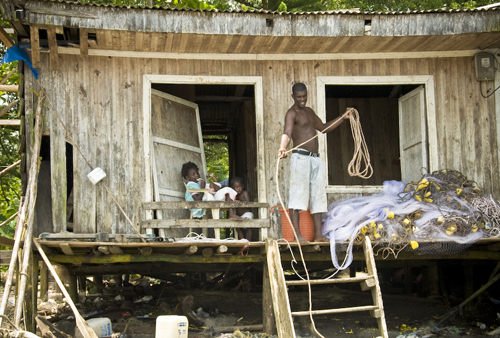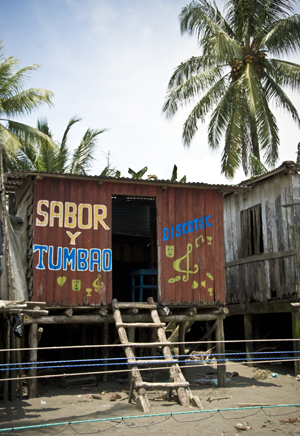

This is HuffPost World's regular feature that highlights interesting musicians and musical trends around the world. Know of a great musician doing ground-breaking work outside the United States? Send us your ideas for bands to profile or up-and-coming musicians to follow. Please fill out this survey form.
By Marlon Bishop
Even as headlines in American newspapers boast decreasing violence in Colombia, crime in Buenaventura, the country's sweltering Pacific port, is a fact of daily life. A principal export point for cocaine, this fast-growing city of over 300,000 is stuck in a turf war between left-wing revolutionary groups and right-wing paramilitary armies, each vying for control of the drug trade. Civilians are often caught in the crossfire. The homicide rate is four times that of Medellin, the city once infamous as the bloody capital of Pablo Escobar's cocaine empire.
Yet there is more to Buenaventura. Otrabanda, a record label based in Amsterdam, has recently released an album that shows another side of the city -- as the beating heart of the Pacific music scene. Pacifico Colombiano is homage to a vast trove of Afro-Colombian music styles that, until now, have received little international attention. These styles range from otherworldly marimba jams to upbeat, swaggering chirimia, in which local rhythms are interpreted by a quirky ensemble of clarinet, snare drum, and euphonium, an obscure piece of European military brass. The album compiles tracks from artists that range from veteran dance orchestras to young hip-hop and fusion groups.
In addition to having its own musical stamp, Buenaventura is a huge salsa town. As the country's principal port, the first salsa cuts coming out of New York in the 1960s arrived here first before spreading to the rest of Colombia. In fact, trumpeter and bandleader Francisco Pena, who coordinated the production of Pacifico Colombiano, got his start playing in the salsa scene before he got into researching local roots music. He taught music at Cali's Universidad Del Valle before relocating to the Netherlands in 2000. There, he met Otrabanda president Scott Rollins, whose label primarily puts out music from the former Dutch colonies of Suriname and Curucao. "Once I came to Holland," says Pena. "I began to look at some of the rhythms of the Dutch Antilles, and I saw they had the same rhythmic identity as Afro-Colombian music. It all grows from the same root: Africa."
Many Americans mistakenly believe that Colombian music consists entirely of Shakira and cumbia, the sauntering Afro-Colombian beat of the country's Caribbean coast. But in fact, the musical diversity in Colombia is staggering, thanks to a landscape that includes two coasts, the soaring Andes, and a chunk of the Amazon rainforest.
In great contrast to Cartagena, the Caribbean coasts' glamorous pleasure-town, Buenaventura is a poor city surrounded by beautiful yet unforgiving geography. The area, one of the rainiest places in the world, second only to Hawaii's Mount Waialeale, is a land of dense jungles, mangrove forests and twisting rivers. These Pacific lowlands, stretching seamlessly into Northern Ecuador, served as a free black nation of sorts during the Colonial Era. The environment made it easy for Africans, brought in the 16th century and forced to work in the mines, to form palenques --or free communities of escaped slaves -- far beyond the Colonial heel. As a result, the culture of the Pacific Coast developed largely untouched by the Spanish authorities, and today, over 80% of area residents are Afro-Colombian.
The old ways of the Pacific are best maintained in the stilt towns that line the myriad rivers and on islands of mangroves, where motorized canoes speed smoothly down the watery superhighways. Here, residents play some of the most deeply African music in the New World on marimbas that differ little in construction from instruments played in West Africa to this day.
"I've been to the villages a few times, but way up the rivers," says Pena. In rural areas, musicians play in dedicated marimba houses, big wooden structures that host village parties. "In the marimba house, the music never stops, and if one of the elders gets tired, someone goes up and takes his place." At these casas de marimba, marimbas and bass drums hang from the ceiling rafters on cords that carry vibrations throuhout the structure, amplifying the music with the building itself as the soundbox. Marimberos improvise verses over currulao, the swinging and heavily syncopated 6/8 groove of the Pacific.
Chirimia, the other major Pacific musical tradition in the Pacific, is basically an Afro-Colombian marching-band dance party. Inspired by military brass bands, the chirimia got its sound in the early 20th century as laborers from Cuba, Jamaica, and the French Antilles came to work on sugar-cane ventures in the region. Cuban sounds mixed with Anglophone calypso and created a distinctive local son flavor, sounding vaguely like a New Orleans second-line band on a tropical getaway. With lots and lots of clarinets.
Though Afro-Colombians comprise, by some estimates, up to a quarter of Colombia's population, they represent only a small percentage of business owners and politicians. Like people of color all over Latin America, blacks experience frequent social discrimination; the reigns of this continent's power have remained firmly in the hands of the Euro-centric elite since the Spanish conquest and settlement of the region. This exclusionary attitude makes counting the number of Colombians with African ancestry difficult: many people of mixed origins will actively avoid identifying with such a marginalized community.
Racism may well be one of the roots of Buenaventura's social ills. The government spends far less money on infrastructure and development in heavily Afro-Colombian regions than in other areas, especially the wealthy mestizo highlands.
"Sixty percent of Colombia's wealth enters via Buenaventura's port, but nothing stays," says Pena. "Everything goes to the Andes, to Bogota." And since the job market remains stagnant many young people turn to the drug business. It's big money: Ninety percent of the cocaine consumed in the US comes from Colombia, much of it stashed away in the cargos of Buenaventura's trawlers.

In the past few decades, the country's 50-year-long internal conflict with the leftist Revolutionary Armed Forces of Colombia (F.A.R.C), and right-wing paramilitary armies has turned from a clash of ideologies to a drug war, inflicting particular damage on the Pacific Coast. In the shantytowns of Buenaventura, whole neighborhoods lay in the hands of opposing factions, and nobody dares cross. Even greater violence in rural areas is sparking a refugee crisis, with terrorized rural families crossing the southern border to Ecuador or moving to the comparative safety of Buenaventura's slums. President Uribe, a hardliner from the center-right party and grand friend to the former Bush administration, is promising to increase security in the region.
Life goes on, adapts. Francisco is concerned about the struggle to get young people interested in their roots. "We are suffering the problem of the American Dream," he says. "The kids in my town wear American clothes, use American words, only the houses are smaller." Yet Pacifico Colombiano is filled with cross-generational fusions, such as the marimba-inflected rap of Choc Quib Town and the hip global stylings of cosmopolitan Cali songstress Liliana Montes. On one track, a classic chirimia breaks down into a dancehall-style rap.
The producers of Pacifico Colombiano were careful to include the full range of Pacific Colombian musical expressions in their compilation. Alongside Grupo Naidy's traditional marimba track "Adios Guapi" and Alfonso's sassy chirimiya jam "El Piloto", the album features a number of old-school Latin dance bands. One such group, Peregoyo y su Combo Vacana, was the first national musical sensation to bring Pacific music to the rest of the country in the 1960s. On the album, they play salsa-style pop over the tricky local beat, earning bandleader Peregoyo the title "King of Currulao."
Francisco Pena's own father, Pacho, makes an appearance with his chirimia group. In turn, the junior Pena contributes a track with his Amsterdam-based collective Barrio Nuevo, which teams Afro-Colombian musicians with players from the Dutch Antilles. Producers Pena and Higgins hope that, as the first compilation of its type, Pacifico Colombiano turns some heads to an underappreciated corner of the world music universe. "I just want people to realize what musical richness we have. It's something new," Francisco says. "Colombia is much bigger than just cumbia. We have lot of other things going on."
For more information on Colombiano Pacifico, click hereTo read the New York Times' 2007 article about violence in Buenavtentura, click here.You can see a YouTube one of the artists featured on the album, Choc Quib Town, hereA short documentary, in Spanish, about the 2008 Marimba Festival in Cali, here
Marlon Bishop can be contacted at marloniousthunk@gmail.com
Read other Global Music Corner stories.
